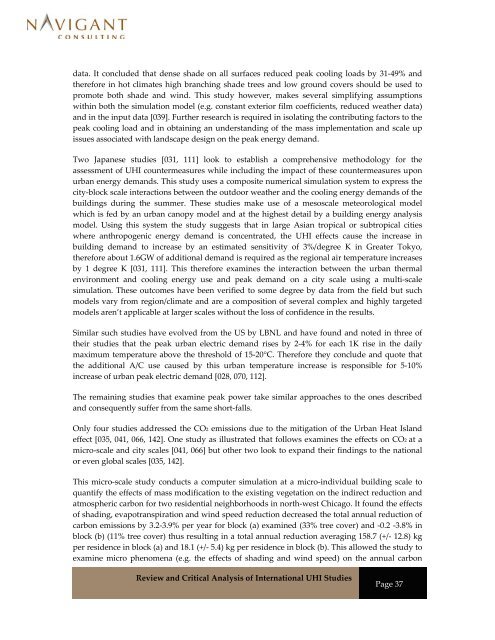Review and Critical Analysis of International UHI Studies
Review and Critical Analysis of International UHI Studies
Review and Critical Analysis of International UHI Studies
Create successful ePaper yourself
Turn your PDF publications into a flip-book with our unique Google optimized e-Paper software.
data. It concluded that dense shade on all surfaces reduced peak cooling loads by 31‐49% <strong>and</strong><br />
therefore in hot climates high branching shade trees <strong>and</strong> low ground covers should be used to<br />
promote both shade <strong>and</strong> wind. This study however, makes several simplifying assumptions<br />
within both the simulation model (e.g. constant exterior film coefficients, reduced weather data)<br />
<strong>and</strong> in the input data [039]. Further research is required in isolating the contributing factors to the<br />
peak cooling load <strong>and</strong> in obtaining an underst<strong>and</strong>ing <strong>of</strong> the mass implementation <strong>and</strong> scale up<br />
issues associated with l<strong>and</strong>scape design on the peak energy dem<strong>and</strong>.<br />
Two Japanese studies [031, 111] look to establish a comprehensive methodology for the<br />
assessment <strong>of</strong> <strong>UHI</strong> countermeasures while including the impact <strong>of</strong> these countermeasures upon<br />
urban energy dem<strong>and</strong>s. This study uses a composite numerical simulation system to express the<br />
city‐block scale interactions between the outdoor weather <strong>and</strong> the cooling energy dem<strong>and</strong>s <strong>of</strong> the<br />
buildings during the summer. These studies make use <strong>of</strong> a mesoscale meteorological model<br />
which is fed by an urban canopy model <strong>and</strong> at the highest detail by a building energy analysis<br />
model. Using this system the study suggests that in large Asian tropical or subtropical cities<br />
where anthropogenic energy dem<strong>and</strong> is concentrated, the <strong>UHI</strong> effects cause the increase in<br />
building dem<strong>and</strong> to increase by an estimated sensitivity <strong>of</strong> 3%/degree K in Greater Tokyo,<br />
therefore about 1.6GW <strong>of</strong> additional dem<strong>and</strong> is required as the regional air temperature increases<br />
by 1 degree K [031, 111]. This therefore examines the interaction between the urban thermal<br />
environment <strong>and</strong> cooling energy use <strong>and</strong> peak dem<strong>and</strong> on a city scale using a multi‐scale<br />
simulation. These outcomes have been verified to some degree by data from the field but such<br />
models vary from region/climate <strong>and</strong> are a composition <strong>of</strong> several complex <strong>and</strong> highly targeted<br />
models aren’t applicable at larger scales without the loss <strong>of</strong> confidence in the results.<br />
Similar such studies have evolved from the US by LBNL <strong>and</strong> have found <strong>and</strong> noted in three <strong>of</strong><br />
their studies that the peak urban electric dem<strong>and</strong> rises by 2‐4% for each 1K rise in the daily<br />
maximum temperature above the threshold <strong>of</strong> 15‐20°C. Therefore they conclude <strong>and</strong> quote that<br />
the additional A/C use caused by this urban temperature increase is responsible for 5‐10%<br />
increase <strong>of</strong> urban peak electric dem<strong>and</strong> [028, 070, 112].<br />
The remaining studies that examine peak power take similar approaches to the ones described<br />
<strong>and</strong> consequently suffer from the same short‐falls.<br />
Only four studies addressed the CO2 emissions due to the mitigation <strong>of</strong> the Urban Heat Isl<strong>and</strong><br />
effect [035, 041, 066, 142]. One study as illustrated that follows examines the effects on CO2 at a<br />
micro‐scale <strong>and</strong> city scales [041, 066] but other two look to exp<strong>and</strong> their findings to the national<br />
or even global scales [035, 142].<br />
This micro‐scale study conducts a computer simulation at a micro‐individual building scale to<br />
quantify the effects <strong>of</strong> mass modification to the existing vegetation on the indirect reduction <strong>and</strong><br />
atmospheric carbon for two residential neighborhoods in north‐west Chicago. It found the effects<br />
<strong>of</strong> shading, evapotranspiration <strong>and</strong> wind speed reduction decreased the total annual reduction <strong>of</strong><br />
carbon emissions by 3.2‐3.9% per year for block (a) examined (33% tree cover) <strong>and</strong> ‐0.2 ‐3.8% in<br />
block (b) (11% tree cover) thus resulting in a total annual reduction averaging 158.7 (+/‐ 12.8) kg<br />
per residence in block (a) <strong>and</strong> 18.1 (+/‐ 5.4) kg per residence in block (b). This allowed the study to<br />
examine micro phenomena (e.g. the effects <strong>of</strong> shading <strong>and</strong> wind speed) on the annual carbon<br />
<strong>Review</strong> <strong>and</strong> <strong>Critical</strong> <strong>Analysis</strong> <strong>of</strong> <strong>International</strong> <strong>UHI</strong> <strong>Studies</strong><br />
Page 37


